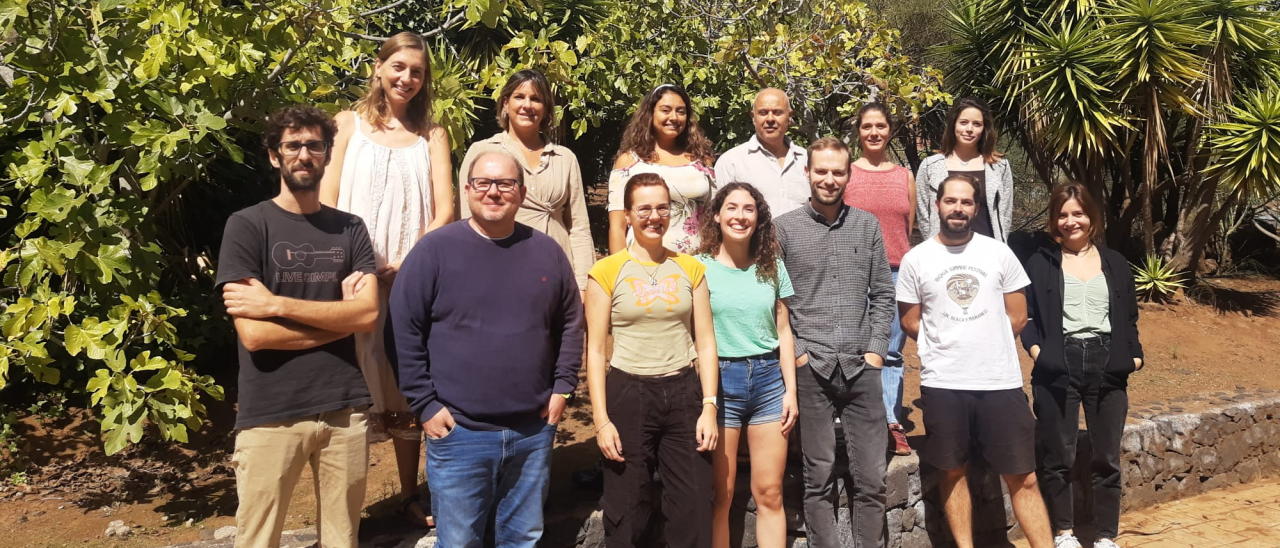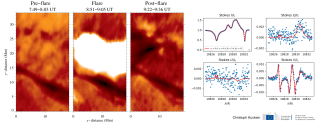Subvenciones relacionadas:
General
Bienvenida a la página web del grupo de investigación Traces of Galaxy Formation.
Somos un grupo de investigación amplio, diverso y muy activo cuyo objetivo principal es entender la formación de galaxias en el Universo de una manera lo más completa posible. Con el estudio detellado de las poblaciones estelares como bandera, estamos constantemente buscando y desarrollando nuevas herramientas e ideas que nos permitan entender cómo las galaxias han llegado a convertirse en lo que hoy observamos.
Una historia de formación compleja, como la que se espera describa la evolución de las galaxias, necesita de un acercamiento multidisciplinar para ser entendida. Nuestro grupo en el IAC está compuesto por personal investigador de gran experiencia en simulaciones cosmológicas, estudios dinámicos, análisis de poblaciones estelares y caracterizaciones morfológicas de galaxias tanto locales como a alto corrimiento al rojo. Combinamos distintas alternativas (e.g. observaciones y teoría o procesos de evolución secular y cosmológica) para poder alcanzar en los próximos años una visión consistente de los mecanismos físicos que regulan la formación de las galaxias.
Dentro de este esquema general, estamos principalmente centrados en el estudio de tres líneas centrales:
- Modelos de síntesis de poblaciones estelares
- Desarrollo de modelos de poblaciones estelares
- Métodos de análisis para el estudio de poblaciones estelares
- Universalidad de la función inicial de masa (IMF)
- Evolución cósmica de galaxias
- Evolución de galaxias masivas
- Poblaciones estelares en distintos entornos
- Ciencia a bajo brillo superficial
- Simulaciones númericas y aprendizaje automático
- Procesos evolutivos en galaxias cercanas
- Agujeros negros como moduladores de la formación estelar
- Cartogrtafiados locales
- Cinemática estelar y modelos dinámicos
Si quieres ponerte en contacto o trabajar con el grupo, por favor, envía un correo al investigador principal (Ignacio Martín-Navarro ignacio.martin [at] iac.es (ignacio[dot]martin[at]iac[dot]es)).
Miembros
Resultados
Esta es una muestra de algunos de nuestros resultados destacados más recientes:
- Local variations of the stellar velocity ellipsoid - II. The effect of the bar in the inner regions of Auriga galaxies. Walo et al. 2022, MNRAS (https://ui.adsabs.harvard.edu/abs/2022MNRAS.513.4587W)
- Anisotropic satellite galaxy quenching modulated by black hole activity. Martín-Navarro et al. 2021, Nature (https://ui.adsabs.harvard.edu/abs/2021Natur.594..187M)
- Evaluating hydrodynamical simulations with green valley galaxies. Angthopo et al. 2021, MNRAS (https://ui.adsabs.harvard.edu/abs/2021MNRAS.502.3685A)
- Sub one per cent mass fractions of young stars in red massive galaxies. Salvador-Rusiñol et al. 2020, Nature Astronomy (https://ui.adsabs.harvard.edu/abs/2020NatAs...4..252S)
- Detection of young stellar populations in apparently quenched low-mass galaxies using red spectral line indices. de Lorenzo-Cáceres et al. 2020, MNRAS (https://ui.adsabs.harvard.edu/abs/2020MNRAS.498.1002D)
Actividad científica
Publicaciones relacionadas
-
The SAURON project - XIX. Optical and near-infrared scaling relations of nearby elliptical, lenticular and Sa galaxies
We present ground-based MDM Observatory V-band and Spitzer/InfraRed Array Camera 3.6-?m-band photometric observations of the 72 representative galaxies of the SAURON survey. Galaxies in our sample probe the elliptical E, lenticular S0 and spiral Sa populations in the nearby Universe, both in field and cluster environments. We perform aperture
Falcón-Barroso, J. et al.Fecha de publicación:
112011 -
The SAURON Project - XIV. No escape from Vesc: a global and local parameter in early-type galaxy evolution
We present the results of an investigation of the local escape velocity (Vesc) - line strength index relationship for 48 early-type galaxies from the SAURON sample, the first such study based on a large sample of galaxies with both detailed integral field observations and extensive dynamical modelling. Values of Vesc are computed using multi
Scott, Nicholas et al.Fecha de publicación:
102009 -
The SAURON project - XIII. SAURON-GALEX study of early-type galaxies: the ultraviolet colour-magnitude relations and Fundamental Planes
We present Galaxy Evolution Explorer far-ultraviolet (FUV) and near-ultraviolet (NUV) imaging of 34 nearby early-type galaxies from the SAURON representative sample of 48 E/S0 galaxies, all of which have ground-based optical imaging from the MDM Observatory. The surface brightness profiles of nine galaxies (~26 per cent) show regions with blue UV
Jeong, Hyunjin et al.Fecha de publicación:
102009 -
The Nature of Fossil Galaxy Groups: Are They Really Fossils?
We use SDSS-DR4 photometric and spectroscopic data out to redshift z ~ 0.1 combined with ROSAT All Sky Survey X-ray data to produce a sample of 25 fossil groups (FGs), defined as bound systems dominated by a single, luminous elliptical galaxy with extended X-ray emission. We examine possible biases introduced by varying the parameters used to
La Barbera, F. et al.Fecha de publicación:
42009 -
The link between the star formation history and [α/Fe ]
The abundance ratios between key elements such as iron and α-process elements carry a wealth of information on the star formation history (SFH) of galaxies. So far, simple chemical evolution models have linked [α/Fe ] with the SFH time-scale, correlating large abundance ratios with short-lived SFH. The incorporation of full spectral fitting to the
de la Rosa, I. G. et al.Fecha de publicación:
112011 -
The Einstein Cross: Constraint on Dark Matter from Stellar Dynamics and Gravitational Lensing
We present two-dimensional line-of-sight stellar kinematics of the lens galaxy in the Einstein Cross, obtained with the GEMINI 8 m telescope, using the GMOS integral-field spectrograph. The stellar kinematics extend to a radius of 4'' (with 0farcs2 spaxels), covering about two-thirds of the effective (or half-light) radius Re ~= 6'' of this early
van de Ven, Glenn et al.Fecha de publicación:
82010 -
Superdense Massive Galaxies in the Nearby Universe
Superdense massive galaxies (re ~ 1 kpc; M ~ 1011 M sun) were common in the early universe (z gsim 1.5). Within some hierarchical merging scenarios, a non-negligible fraction (1%-10%) of these galaxies is expected to survive since that epoch, retaining their compactness and presenting old stellar populations in the present universe. Using the NYU
Trujillo, I. et al.Fecha de publicación:
22009 -
Stellar velocity profiles and line strengths out to four effective radii in the early-type galaxies NGC3379 and 821
We use the integral-field spectrograph SAURON to measure the stellar line-of-sight velocity distribution and absorption line strengths out to four effective radii (Re) in the early-type galaxies NGC 3379 and 821. With our newly developed observing technique, we can now probe these faint regions in galaxies that were previously not accessible with
Weijmans, Anne-Marie et al.Fecha de publicación:
92009 -
Stellar Kinematics in Double-Barred Galaxies: The σ-Hollows
We present SAURON integral-field stellar velocity and velocity dispersion maps for four double-barred early-type galaxies: NGC 2859, NGC 3941, NGC 4725, and NGC 5850. The presence of the inner bar does not produce major changes in the line-of-sight velocity, but it appears to have an important effect in the stellar velocity dispersion maps: we find
de Lorenzo-Cáceres, A. et al.Fecha de publicación:
92008 -
On the Radial Stellar Content of Early-type Galaxies as a Function of Mass and Environment
Using optical-optical and optical-NIR colors, we analyze the radial dependence of age and metallicity inside massive (M sstarf >~ 1010.5 M sun), low-redshift (z < 0.1), early-type galaxies (ETGs), residing in both high-density group regions and the field. On average, internal color gradients of ETGs are mainly driven by metallicity, consistent with
La Barbera, F. et al.Fecha de publicación:
102011 -
MIUSCAT: extended MILES spectral coverage - II. Constraints from optical photometry
In this work, we show a comprehensive comparison of our new stellar population synthesis (SPS) MIUSCAT models with photometric data of globular clusters (GCs) and early-type galaxies.The models compare remarkably well with the colours of Milky Way GCs in the optical range. Likewise, the colours of M31 GCs can also be explained by the models by
Ricciardelli, E. et al.Fecha de publicación:
72012 -
MIUSCAT: extended MILES spectral coverage - I. Stellar population synthesis models
We extend the spectral range of our stellar population synthesis models based on the MILES and CaT empirical stellar spectral libraries. For this purpose, we combine these two libraries with the Indo-U.S. to construct composite stellar spectra to feed our models. The spectral energy distributions (SEDs) computed with these models and the originally
Vazdekis, A. et al.Fecha de publicación:
72012 -
Evolutionary stellar population synthesis with MILES - I. The base models and a new line index system
We present synthetic spectral energy distributions (SEDs) for single-age, single-metallicity stellar populations (SSPs) covering the full optical spectral range at moderately high resolution [full width at half-maximum (FWHM) = 2.3Å]. These SEDs constitute our base models, as they combine scaled-solar isochrones with an empirical stellar spectral
Vazdekis, A. et al.Fecha de publicación:
62010 -
Dissecting the size evolution of elliptical galaxies since z˜ 1: puffing-up versus minor-merging scenarios
At a fixed stellar mass, the size of low-redshift early-type galaxies is found to be a factor of 2 larger than that of their counterparts at z˜ 1, a result with important implications for galaxy formation models. In this paper, we have explored the buildup of the local mass-size relation of elliptical galaxies using two visually classified samples
Trujillo, I. et al.Fecha de publicación:
82011 -
Dissecting Early-type Dwarf Galaxies into Their Multiple Components
Early-type dwarf galaxies, once believed to be simple systems, have recently been shown to exhibit an intriguing diversity in structure and stellar content. To analyze this further, we started the SMAKCED project (Stellar content, MAss and Kinematics of Cluster Early-type Dwarfs, http://www.smakced.net) and obtained deep H-band images for 101 early
Janz, J. et al.Fecha de publicación:
22012 -
Discovery of an Active Galactic Nucleus Driven Molecular Outflow in the Local Early-type Galaxy NGC 1266
We report the discovery of a powerful molecular wind from the nucleus of the non-interacting nearby S0 field galaxy NGC 1266. The single-dish CO profile exhibits emission to ±400 km s-1 and requires a nested Gaussian fit to be properly described. Interferometric observations reveal a massive, centrally concentrated molecular component with a mass
Alatalo, K. et al.Fecha de publicación:
72011 -
Constraints on Feedback Processes during the Formation of Early-type Galaxies
Galaxies are found to obey scaling relations between a number of observables. These relations follow different trends at the low- and high-mass ends. The processes driving the curvature of scaling relations remain uncertain. In this Letter, we focus on the specific family of early-type galaxies, deriving the star formation histories of a complete
Trevisan, M. et al.Fecha de publicación:
62012 -
An updated MILES stellar library and stellar population models
Aims: We present a number of improvements to the MILES library and stellar population models. We correct some small errors in the radial velocities of the stars, measure the spectral resolution of the library and models more accurately, and give a better absolute flux calibration of the models. Methods: We use cross-correlation techniques to
Falcón-Barroso, J. et al.Fecha de publicación:
82011 -
Estimation of Galactic Model Parameters in High Latitudes with SDSS
We estimated the Galactic model parameters for a set of 36 high-latitude fields included in the currently available Data Release 5 (DR 5) of the Sloan Digital Sky Survey (SDSS), to explore their possible variation with the Galactic longitude. The thick disc scaleheight moves from ˜550 pc at 120°
Bilir, S. et al.Fecha de publicación:
02008 -
Comparison of star formation rates from Hα and infrared luminosity as seen by Herschel
We empirically MD test the relation between the SFR(LIR) derived from the infrared luminosity, LIR, and the SFR(Hα) derived from the Hα emission line luminosity using simple conversion relations. We use a sample of 474 galaxies at z = 0.06-0.46 with both Hα detection [from 20k redshift Cosmological Evolution (zCOSMOS) survey] and new far-IR
Domínguez-Sánchez, H. et al.Fecha de publicación:
102012



